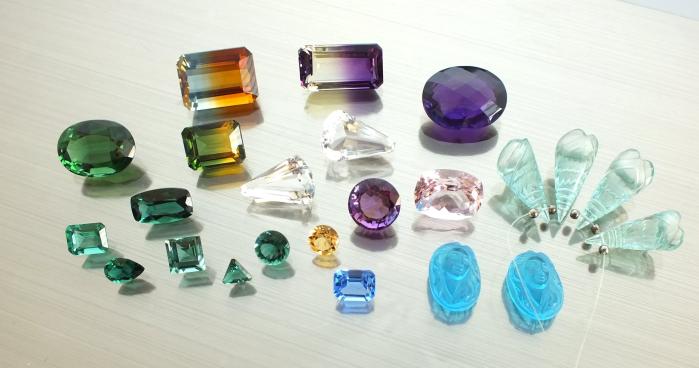 |
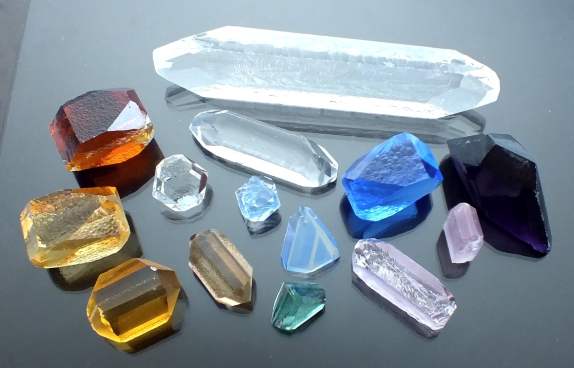 |
| 多彩な色合いの合成水晶 8.46 -
21.02ct Colorful synthetic quartz |
様々な色と形の合成水晶結晶 35mm-200mm (Synthetic Quartz Crystals) |
合成水晶(Synthetic
Quartzs)
 |
 |
| 多彩な色合いの合成水晶 8.46 -
21.02ct Colorful synthetic quartz |
様々な色と形の合成水晶結晶 35mm-200mm (Synthetic Quartz Crystals) |
恐らく大半がロシア製と考えられますが、様々な色の合成水晶が市場に流通しています。
水晶はこんにち主に時計、コンピューター等エレクトロニクスの基幹部品、また高精細ビデオ・カメラ、デジタル・カメラの
モアレ(干渉縞)低減用の光学フィルターとして広範に使われています。
そしてこれらの水晶は全て合成水晶が使われ、その生産量は年間数千トンを優に越えると思われます。
主な生産国は日本、アメリカ、ロシアです。
とりわけ旧ソ連時代から主に軍事用途を目的に膨大な予算と科学者とを投入して鉱物結晶の合成が試みられて来た
ロシアでは合成水晶の分野では圧倒的な技術力の蓄積があり、本来軍事用には全く必要のない宝石用の様々な色の
水晶が合成されています。
豊富な予算に飽かして科学者が個人の趣味で宝石用の多色の水晶合成を試みたに違いありません。
まことに天晴れな心がけです。
おかげで天然にはない実に多彩な色合いの水晶を楽しむことができると言うものです。
Varieties of colorful synthetic quartzs, great probably made in Russia, are now available in the market.
Today, far more than several thusand tons of quartz are manufactured annually, in Japan, U.S.A. and in Russia,
mainly for electronics and for optical equipments use.
Russia, having been experimented an extensive efforts in synthesizing mineral crystals, mainly for military purposes
since Soviet Russia Epoch, is considered as the leader particularly in quartz synthesis technology.
Although entirely useless for military purpose, Russian scientests have succeeded in achieving outstanding technology
in creating colorful quartz crystals.
合成紫水晶とアメトリン (Synthetic Amethyst and Ametrine)
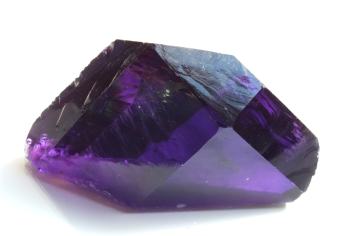 |
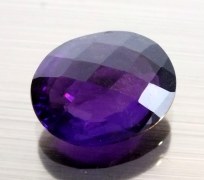 |
 |
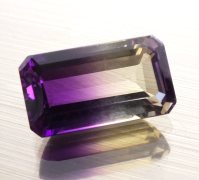 |
| 合成紫水晶 (Symnthetic Amethyst) 81x50x27mm 124g | 合成紫水晶 (Synthetic
Amethyst) 19.57ct 21x17x9.3mm |
合成アメトリン (Synthetic Ametrine) | |
| 6.82ct Ø12mm | 18.48ct 21x12x9mm | ||
| Russia | |||
紫水晶とアメトリンとは天然に発見される水晶です。
紫色は放射線照射によって不純物として微量に含まれる4価の鉄イオンが形成するカラー・センターによる光の吸収で発色
することが明らかにされています。
一方黄色は酸素と鉄イオンによる電荷移動という仕組みに加えて、三価のアルミニウム・イオンによるカラー・センターが
加わり淡黄色ー金色ー濃橙色に至る広範な色合いの発色が起こります。
天然には黄色の水晶は極めて稀にしか発見されません。市場のほぼ全ての黄水晶は紫水晶を加熱処理したものです。
1970年代頃から市場に出現した黄色と紫の二色の水晶は永らく人工ではないかと疑われていましたが1993年にようやく
ボリビアのアナイ鉱山の天然の水晶と判明しました。
石灰岩層に貫入した熱水にて単結晶である黄水晶分とブラジル式双晶の紫水晶分とが合わさって成長した特異な条件下
で世界で唯一の二色の水晶が出来たわけです。
旧ソ連時代から水晶合成の分野で際立った技術を蓄積してロシアでは既に実験室段階では1960年代には合成アメトリン
を実現していましたから、1994年にはいち早くアメトリンの量産技術を確立し、今や年間数トンと天然の5倍の量の生産設備
を持っています。
Both amethyst and ametrine are discovered in nature. Violet to purple color of amethyst is caused by O2- - Fe4+
charge transfer, due to irradiation, while wide color range of pale yellow-golden-deep orange of citrine is the result of
various Al3+ related color centers, in addition to O2- - Fe3+ charge transfer.
Citrine is rarely encountered in nature and almost all citrines in the market are made from irradiated amethyst.
When ametrine appeared since 1970's, it has been suspected their origine as artificial, but was revealed natural one
from Anahí mine, Bolivia near Brazilian boarder in 1993.
The unusual color patterns result from uncommon geologic conditions to grow the combination of
yellow single-crystal together with purple Brazilian-law twin crystal.
Russia, having experimented intensive quartz synthesizing technology, mainly for military purpose since Soviet Epoch,
had suceeded in creating ametrine in 1960's in laboratory level, has established the mass production facility in 1994
and now has capacity of 5000 kilogram of ametrine, which is 5 times of natural ametrine production.
合成黄水晶 (Synthetic Citrine)
 |
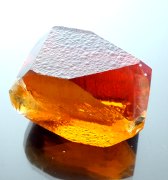 |
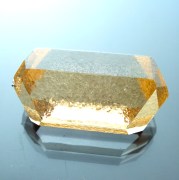 |
 |
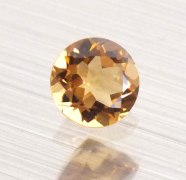 |
| 48x34x26mm 66g | 51x41x29mm 113g | 47x23x18mm 33g | 51x34x29mm | 1.12ct Ø7.1mm |
シトリンは天然には極めて稀にしか採れない水晶です。にも拘らず、手ごろな値段で宝石市場で大量に見かけられるのは、世界で年間数百トンと、大量に採れる紫水晶や黒水晶を加熱処理して得られるためです。
美しくカットされたシトリンは、金色のサファイアやインペリアル・トパーズと比べても遜色のない魅力的な宝石ですが、値段が安いためでしょう、一般に軽んじられているのは全く残念なことです。
名前の由来であるシトラス(柑橘類)同様、合成黄水晶にも金色、褐色を帯びた橙色、淡黄、黄色、淡緑、濃緑、と天然より多彩な色合いがあります。
これらの発色は不純物として含まれる微量の鉄と水晶の主成分の一つである酸素との電荷状態による電荷移動やカラーセンターが原因です。
合成シトリンでは鉄の成分比を自由に変えられるため多彩な色の発色が可能です。
残念ながら、合成水晶は宝石として殆ど省みられないため、カットされることも、アクセサリーとして彫刻されることも滅多にありません。
Cirine is extremely rare in the nature. However, citrine is abundant in jewelry market at quite available cost. Almost all of gem citrines are aritificially heat treated one from amethyst and morion (black or smoky quartz) .
Despite it's attractive golden color and brilliance, comparable to far expensive golden sapphire or imperial topaz, citrine is considered as an inferior gemstone, due to too less expensive price.
Synthetic citrine has a lot of color variations, as its origine of citrus fruits group. Thes vaiations of colors are due to
charge transfer and color center caused by various color centers and charge transfer between Fe+2, O2 » Fe+3.
Because iron ion impurity can be artificially changeable at any rate, any color variations are possible.
合成緑水晶 (Synthetic green quartz)
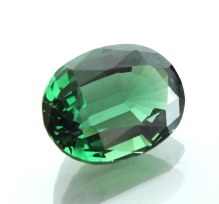 |
 |
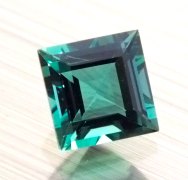 |
 |
| 13.98ct 18.9x13.7x8.8mm | 2.11ct 9.2x7.1mm | 2.45ct 8.0x8.0mm | 1.09ct 9.0x6.0mm |
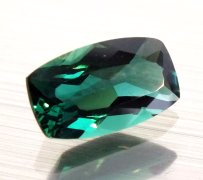 |
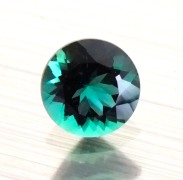 |
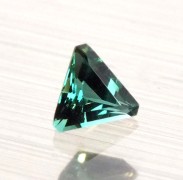 |
 |
| 4.07ct 14.0x8.2mm | 1.67ct Ø8.0mm | 0.60ct 6.0mm | 結晶 30x28x17mm 19g |
天然には緑色の水晶は大変稀に発見されます。 ただし最近、天然の主にブラジルのモンテズマ鉱山産の紫水晶を加熱処理したグリーンド・アメシストと呼ばれる淡緑色の水晶が市場に出回っています。
緑の発色は二価の鉄イオンによる発色です。
発色原理は至って単純ですから合成の緑の水晶を作るのも簡単です。
しかし鉄分を多くしても、結晶の写真のように色むらができてしまいます。
ルースはすべて均一の色合いですが、これはロシアの超絶的な合成技術があってこそ可能です。
ただし市場での需要は殆どありませんから緑の合成水晶は滅多に見かけません。
13.97カラットの石は珍しく大きく美しいものです。
Green quartz is extremely rare in the nature. Recently, however, pale green quarts, so-called greened-amethyst
appeared in the market. This green quartz is actually the heat treated amethyst from Montezma mine, Brazil.
Green color is caused by color center of Fe2+ impurity, which mechanism is applied in creating synthetic green quartz.
However, as seen in green crystal, it is quite difficult to realize evenly colored stone.
All faceted stones are evenly colored, thanks to the outstanding synthesis technic of Russian scientists.
The 13.98ct stone is an example of large faceted stone of attractive green color.
二色の合成水晶(Synthetic bi-color quartzs)
 |
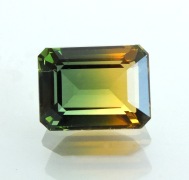 |
| 青と黄、二色の水晶 21.02ct 19.1x14.4x7.7mm (Blue and yellow, bi-color quartz) |
黄色と緑、二色の水晶 8.46ct 14.3x8.4x5.2mm (Yellow and green, bi-color quartz) |
| Russia | |
天然にはインクルージョンを含む場合は別として、透明な青い水晶はありません。
また緑の水晶も極めて稀、宝石質の黄水晶も滅多にありません。
したがって青と黄、黄と緑の二色の水晶は天然には存在しません。
単独の色の合成水晶は黄色は鉄とアルミニウム、緑は鉄、青はコバルトによる発色等々、それぞれの色に応じた元素を
添加すれば比較的容易に多彩な色の水晶を造ることが出来ます。
しかし写真のようなくっきりと二色が分かれた結晶はどのようにして造られたか ?
単純に考えれば一つの色で成長した結晶を一旦熱水溶液から引き上げて、別の色の発色元素を含む溶液中で再結晶
させるという手があります。
一般にはこのように条件を変えて結晶を再成長させた場合にはその境目に何らかのストレスによる影響が現れるはずです。
写真の結晶ではしかし、いずれも二色の境目に何の不連続な様子が見えません。
恐らくは結晶面を平滑に研磨して別の発色元素を含む溶液中で再結晶させたのだろうと考えられます。
Transparent blue quartz does not exist in the nature.
Natural green quartz is extremely rare. Gem quality citrine is rare, either.
Therefore, bi-color quartzs in blue-yellow and yellow-green do not exist in the nature.
It is relatively easy to create artificial mono-colored quartzs in various colors, by adding necessary coloring agents.
However, bi-color quarts with clearly separated to two color bands, as shown in the photos arouse questions ;
How are they created ?
One solution is to simply synthesize in two steps ; overgrow a colored quartz in different coloring solutions, which
should innevitably cause some stresses on epitaxial faces.
But created bi-color quartzs do not show any discontinuity along border zone.
Probably, crystal face is polished before recrystalization in hydrothermal process, containing another coloring agent.
合成薔薇水晶 (Synthetic Rose Quartz)
10.41ct 15.8x11.8mm 結晶 32x23x11mm 19g 結晶 60x21x18mm 48g
薔薇色の水晶はブラジル、マダガスカル、ナミビア等の花崗岩ペグマタイト鉱床で、一般に正長石の結晶を伴い、しかし
何故か他の宝石鉱物を伴なわない単独の鉱脈として大量に発見されます。
日本でもかつては福島県のペグマタイト鉱脈で採掘されたことがあります。
が,世界のどの産地であれ、薔薇色の水晶はほぼ全てが不透明な団塊状で産し、結晶形が見られることは極めて稀です。
そして霞がかかったように半透明なものしか得られません。
その理由は淡いピンクの発色が微細なルチルあるいはデュモルチエ石の結晶を含むためと考えられています。
含まれる微細な結晶による光の乱反射により透明度が損なわれるためと思われます。
1980年代半ばに世界で初めて薔薇色の合成水晶の合成に成功したのは日本でした。
チタンを含むアルカリ溶液中で3cmほどの小さな淡いピンクの結晶が成長しました。が量産には至らず実験室での成功に止まりました。
世界で初めて量産技術を確立したのは1992年、ロシアの材料合成研究所でした。
フッ化アンモニウム溶液に、1リットル当たり1g程のリン酸塩を添加し、プラチナ板で覆った鉄のオートクレーヴ中で
220−350℃、300気圧の条件で1日あたり0.1-0.2mmと、他の色の水晶と比べると10分の1から20分の1のゆっくりとした
成長で2ヶ月余りかけて、最大で大きさが150x40x20mm、重さが140gの結晶が得られました。
結晶はコバルト60によるガンマ線照射により透明なピンクの発色が得られます。
発色の原因は燐イオンに因るカラー・センターと考えられます。
1994年よりロシアでは年間200kgの量産体制を確立したとのことです。
Rose quartz is found in nature in two forms : massive and cystalline.
Massive rose quartz is relatively common in nature ; it originates in granitic pegmatites together with large crysals of
potassiumu feldspar, typically without other gem minerals.
Rose quartz inevitably appears slightly to very cloudy because of inclusions of (micro crystal of rutile or/and dumortierite, that are cause of pink coloration)
青い合成水晶 (Blue Synthetic quarts)
51x35x29mm 102g 20x19x18mmmm 16g 37x32x5mm 8g
2.26ct 9.2x7.1mm 7ct 15.7x11.6mm ea. 7ct 21x10mm ea.
天然に青や空色の水晶はルチル(金紅石)や青いトルマリン等、他の鉱物の微細な結晶を含むものが稀に発見されますが、透明度に欠けるため、宝石には使えません。 したがって青い水晶の宝飾品には全て合成水晶が使われます。
合成には炭酸カリウムやナトリウム等、アルカリ性の溶液に微量のコバルトの酸化物、塩化物、水酸化物等を加えて青色の結晶を成長させます。
素晴らしく美しい色合いの水晶ができますが、青いコバルト・ガラスと全く同じ色合いなので、ルースとしてカットされること
滅多にありません。
彫刻を施されているのはハイドロ・クォーツと呼ばれて売られていた装飾品です。
ハイドロ・クォーツとはハイドロ・サーマル、即ち熱水法 (Hydrothermal method) のことですが、天然であれ合成であれ、
全ての水晶は熱水中で成長するわけですから、特別なものではなく、衒学的な商業名にすぎません。
Blue colored quartz does not exist in nature, except some quarts with micro crystal inclusion of rutile or blue
tourmaline, etc. Therefore, all blue quarts jewelry are of synthetic origne.
Synthetic blue quartz is synthesized in autoclave, filled by water solution of KOH, NaOH with color agent, as
CoCl2, Co2O3, CoCO3 etc.
Synthetic blue quartz is, despite its fascinating color, which resembles to cobalt colored glass, there are few commercial demand.
Instead, so-called hydro-quartz blue accessary is seen sometime. Hydro quartz means hydrothermal quartz but
it's naming is nothing but a commercial gimmick, because all quartz crystals, whatever natural or synthetic, are grown
under hydrothermal conditions.
無色の水晶 (Colorless Quartz)
200x39x24mm 358g 発振子用の水晶の切り出し図
(Quartz Crystal Cuts)8.4ct 9.6ct 88x24x15mm 62g 31x28x16mm 23g 18.5x12.5mm
水晶は結晶軸の特定の方向に薄片を切り出し電圧を加えると極めて安定した周波数で発振する特性があります。
ただし、それは単結晶に限られ、天然の水晶の多くは双晶となっているので発振素子として使えません。
そのために高品質の合成の単結晶水晶が必要となります。
写真の結晶はごく小さなものです。大きいものでは長さ30cm、重さが10kgもの結晶をほぼ1ヶ月程度で熱水法の合成装置で成長させることが可能です。
無色の宝石で宝飾品に使われるのはダイアモンドとキュービック・ジルコニアのみですから、水晶が使われることはまずありません。
しかし、涼しげで手ごろな値段の水晶のネックレス等のアクセサリーを見かけます。、そのほぼ全てが合成水晶と言っても過言ではありません。
写真のペンダント用の水晶も大昔にブラジルで入手したものです。迂闊なことに、長い間ブラジル産の天然の水晶と思っていましたが、ほぼ内包物の無い完璧な水晶ゆえ、これは合成水晶をカットしたものと判断しています。
合成品は天然の水晶を材料に再結晶させてものですから、カットされてしまえば天然の水晶と区別することは不可能です。
合成水晶の値段 (Prices of synthetic quartzs)
年間数百トンと大量に採れるため天然の水晶ルースの市販価格は最も高価な紫水晶やアメトリンの最上品でさえカラット当たり数千円円程度です。
合成水晶となるとアメシストとアメトリンが200円、全く人気の無い緑水晶が100円とガラス並の値段です。
黄色と青、黄色と緑の二色の水晶に至っては天然には全く存在しない色合いですから宝石としての市場価値が無いせいでしょう、カラット当たり150円と叩き売りのような水準です。
これらの値段は原価ではなく、写真のようにカットされたルースの市販価格です、念のため。
即ち写真の21カラットの青と黄の水晶のルースでも3150円なのです。因みにカットは中国かタイで行われたと思われます。
モース硬度が低く劈開性のない水晶のカットは比較的に容易ではありますが、素晴らしい仕上がりです。
ポケットマネーで手軽に入手できるのは嬉しいことではありますが、これらの合成水晶の超絶的な技術の開発と商品化に至るまでの気の遠くなるような時間と努力とに対する評価が反映されたとは凡そ考えられない値段です。
全世界で恐らく10億台を超えて生産されるテレビやコンピューター、デジタルカメラから時計、家電製製品、ビデオゲーム等々、ほぼ全てのエレクトロニクス製品の基幹部品として合成水晶が遍く使われていることで、科学者たちの努力が報いられていると考えるべきなのでしょう。
Despite their incomparable beauty, quatzs are one of the least evaluated gemstones, because of several hundred of tons of annual production.
The best faceted amethyst and citrine are prized at US$10ー60 per carat for loose stones.
Synthetic quartz are prized between US$1.00 to 2.00, whatever their beauty, color and rarity.
The prices are the retail prices of faceted stones and not production cost.
All colored quartz are made in Russia and faceted in China or Thailand with excellent skill.
Although it is pleasant to be able to obtain these faceted stones at pocke money, as gem collector, while it is a regret,considering the efforts and difficulties that scientists have faced in this field, that the final products are sold at unreasonably low level.
We should consider that their efforts are rewarded for the fact that synthetic quarts are employed as key component in entire electronics products, such as TV, PC, digital camera, watch, games and for home appliance products, etc., forannual production of more than one billion pieces.
| Top | Gemhall |